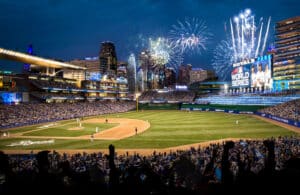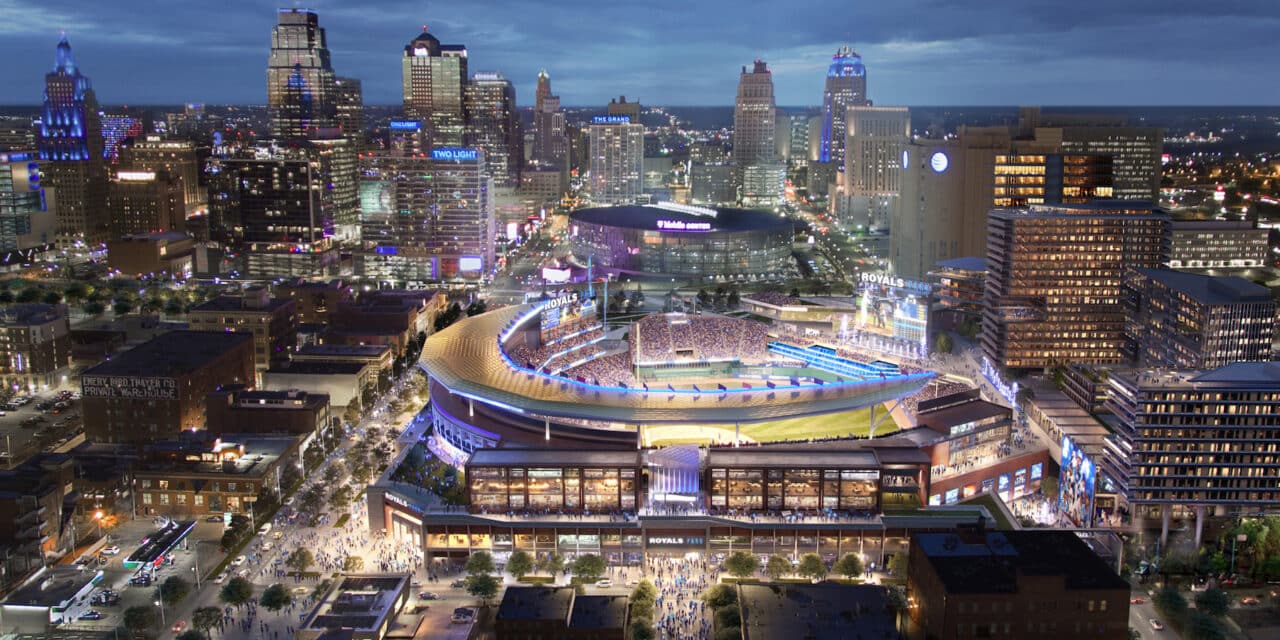ROYAL RENDERING: An image created by Populous shows what the Kansas City Royals’ proposed ballpark could look like downtown on a site near T-Mobile Center. (Courtesy team)
Lack of structure for ballot measure cited
The fallout over a public vote defeating a measure in Kansas City, Missouri to use sales taxes to help fund stadium deals for the Chiefs and Royals remained a hot topic this week across the industry as folks speculated what happens next for the NFL and Major League Baseball teams.
On Tuesday, more than 58% of voters in Jackson County, which covers Kansas City, Missouri, voted to reject a plan to build a new Royals ballpark and renovate Arrowhead Stadium, by replacing the existing three-eighths of a cent sales tax currently in place to pay for maintaining the teams’ venues at the Truman Sports Complex, where both the Chiefs and Royals have played for more than 50 years.
Under the measure, the Royals would have used $1 billion of the new version of the sales tax to pay for a new stadium in downtown Kansas City. The Chiefs would’ve used their share of that revenue to help fund $800 in stadium upgrades, $300 million of which would be paid for privately by the Hunt family, the team’s owner.
Two consultants provided their insight for what they believe led to the decisive no vote. Their comments are on background without being identified due to their work with multiple big league teams, including those in Kansas City. Both of them pointed to the teams’ lack of transparency for their respective developments for what appeared to be a rush job getting the tax measure on the ballot for the April 2 vote.
“One of the things that struck me as odd before the vote was voting on an amount of money without specific project details in place,” said the first consultant, who works with teams and municipalities on stadium financing. “It was like, ‘vote on this now and we’ll cut deals later.’ Normally, the thing that goes last is the vote. I didn’t get that sense. All I got was, the teams still have to negotiate. You don’t know what you’re getting as a (taxpayer). The lack of the deal terms was weird. I thought for sure it would pass.”
A series of events that transpired over the past two months indicate there was some disorganization within the ranks of the Royals, which may have affected the process for getting information out to voters.
On Feb. 13, the Royals held a press conference to announce the downtown site for their proposed ballpark, which they had delayed for several months after considering multiple locations. The press conference caught some people involved in the project off guard, including Populous, the Kansas City architect that’s been working with the Royals on stadium concepts, sources said.
One day after Earl Santee, global chair of Populous and the industry’s foremost ballpark designer, told VenuesNow that he could not provide an update on the Royals project during the Stadium Managers Association seminar in Florida, Santee found himself unexpectedly taking an early flight home to Kansas City to attend the press conference, sources said.
Two weeks later, the Chiefs announced their tentative plan to upgrade Arrowhead, complete with renderings that showed a big tailgate zone on the site where Kauffman Stadium, the Royals’ current ballpark, sits.
The feeling among many in the industry was that the Royals alone could not successfully champion the voters, due to their lack of success on the field, just 10 years after they won the 2014 World Series. It would have to be the Chiefs, winners of three of the last five Super Bowls, that would have to carry the water, so to speak, to get the measure passed.
In the end, it didn’t matter which team was out front stumping for the cause.
In the Royals’ case, the lack of clarity for selecting the site for a new ballpark and entertainment district hurt their chances of getting the vote passed, said the other consultant, a veteran architect. The site, part of the Crossroads district, sits near T-Mobile Center, separated by a highway, and would have required tearing down the old Kansas City Star printing plant, a which opened in 2006.
The Royals had initially considered the site, but were focusing on two other sites before going back to the Crossroads district, the second consultant said.

ROYAL VISION: A rendering from Populous shows fireworks bursting over the proposed downtown Kansas City Royals ballpark. (Courtesy team)
“All of a sudden, it’s the chosen site and that came about over the past seven weeks,” he said. “Renderings were done real quick. It kind of came out of nowhere like a bolt of lightning in some ways.
“Then, about 25 businesses that sit beneath the site would get pushed out,” he said. “There was a grass roots effort to say, ‘you’re killing the little man, we don’t trust you and traffic and parking will be terrible.’ The Royals were literally signing agreements the morning of the vote. The ink was drying while people were going to the voting booth and it essentially got blown out of the water.”
Now, the question is what happens next and whether the Royals and Chiefs could look over the state line to build new facilities in Kansas. It’s a topic that’s been discussed before, and after the vote failed, the option has come to the forefront.
“There was a truce between the two states to stop poaching businesses for tax breaks, but apparently, the governor of Kansas (Laura Kelly), said when they signed it, it didn’t cover sports venues, so the Chiefs (and potentially, the Royals) would fall outside of that language in the truce,” the second consultant said. “Things are changing hourly, but it’s the hottest skillet for news, bar none.”







